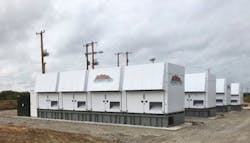Texas-sized Challenge: ERCOT Grid Warning Highlights Need for Lone Star Microgrids
A popular Texas tagline says “it’s a whole other country,” capitalizing on the state’s history as a republic before it was a state. Remember the Alamo, San Jacinto and Sam Houston.
Texas also likes to boast about being in front of key historical trends in energy both of the fossil and renewable variety. Most know about the oil and gas history, but it’s a good thing that the Lone Star State is a leader in microgrid adoption, as weather conditions in recent times are putting a historic strain on its main grid.
On Tuesday, the Electric Reliability Council of Texas, which manages most of the state’s transmission grid traffic, issued a rare Energy Emergency Alert Level 2 to “maintain reliability on the grid.” An earlier alert that same day asking for voluntary conservation was followed by a more imminent warning, as “operating reserves continued to decline,” the ERCOT statement read.
This statement noted that operating reserves had dropped below a 1,750 MW (1.75 GW) margin between available generating capacity and load or demand. Peak demand hit a September record of 81.6 GW (81,674 MW) on Labor Day, one of 10 all-time peak demand records set this summer on the Texas system. Customers set yet another new demand record on Tuesday of more than 82 GW.
In fact, ERCOT issued another conservation request Wednesday and predicted it will likely do so again later in the week.
ERCOT's island unto itself
An imbalance of electricity capacity on the system and higher demand can impact frequency and threaten function on the grid. In February 2021, Winter Storm URI forced numerous losses of generating capacity—including inactive gas wellheads—and high heating and electricity demand forced ERCOT to shed load, or impose forced regional outages, to keep the system in balance.
ERCOT was able to emerge from the latest emergency period without a shutdown or load shedding, but the danger point is easily discerned. By all evidence, the Texas grid, which is almost an island to itself in that it does not directly interconnect with other regional grid systems in the U.S., is under constant duress due to weather conditions such as extreme heat and unpredictable cold which shut down natural gas wellheads.
The state already is a national leader in utility-scale wind power capacity, but more and more Texas is making ample room for microgrids and distributed energy resources such as rooftop solar and battery storage. Two of the nation’s leading microgrid and DER developers, Enchanted Rock and PowerSecure, have commissioned numerous projects there.
Earlier this year, the Texas Legislature approved $1.8 billion toward further microgrid deployment. State Bill 2627 supplies grants for microgrids at about $500 per KW of capacity for facilities up to 2.5 MW. To qualify, the microgrids must be able to provide 48 hours of continuous operations, according to reports.
Virtual power plants growing as part of DER offering
Digital transformation also makes wider and more bi-directional DER deployment possible. ERCOT recently announced it is launching two “virtual power plant” (VPP) pilots this year, making DERs available to dispatch into the main grid if needed. VPPs include software which can aggregate generation capacity from many distributed energy resources and re-allocate into the main grid when peak demand threatens stability of the system.
Texas reportedly is home to more than 200 microgrids, with ERCOT considering interconnection permits for many more.
Microgrids can contribute to sustainability and resiliency, of course, but some reports note a potential financial windfall to installing DERs as opposed to utility-scale transmission investment to meet future electrification expansion. Texas utilities spent close to $41 billion on transmission and distribution infrastructure capital investment in the past 10 years, according to an industry white paper quoted in Microgrid Knowledge in 2021.
The report also estimated that the same utilities could save nearly $350 million a year in T&D investment deferral—or more than $2 billion over a decade—by incorporating more on-site DERs and microgrids.
Track news on microgrid projects. Subscribe to the free Microgrid Knowledge Newsletter.
About the Author
Rod Walton, Microgrid Knowledge Managing Editor
Managing Editor
For Microgrid Knowledge editorial inquiries, please contact Managing Editor Rod Walton at [email protected].
I’ve spent the last 15 years covering the energy industry as a newspaper and trade journalist. I was an energy writer and business editor at the Tulsa World before moving to business-to-business media at PennWell Publishing, which later became Clarion Events, where I covered the electric power industry. I joined Endeavor Business Media in November 2021 to help launch EnergyTech, one of the company’s newest media brands. I joined Microgrid Knowledge in July 2023.
I earned my Bachelors degree in journalism from the University of Oklahoma. My career stops include the Moore American, Bartlesville Examiner-Enterprise, Wagoner Tribune and Tulsa World, all in Oklahoma . I have been married to Laura for the past 33-plus years and we have four children and one adorable granddaughter. We want the energy transition to make their lives better in the future.
Microgrid Knowledge and EnergyTech are focused on the mission critical and large-scale energy users and their sustainability and resiliency goals. These include the commercial and industrial sectors, as well as the military, universities, data centers and microgrids. The C&I sectors together account for close to 30 percent of greenhouse gas emissions in the U.S.
Many large-scale energy users such as Fortune 500 companies, and mission-critical users such as military bases, universities, healthcare facilities, public safety and data centers, shifting their energy priorities to reach net-zero carbon goals within the coming decades. These include plans for renewable energy power purchase agreements, but also on-site resiliency projects such as microgrids, combined heat and power, rooftop solar, energy storage, digitalization and building efficiency upgrades.

